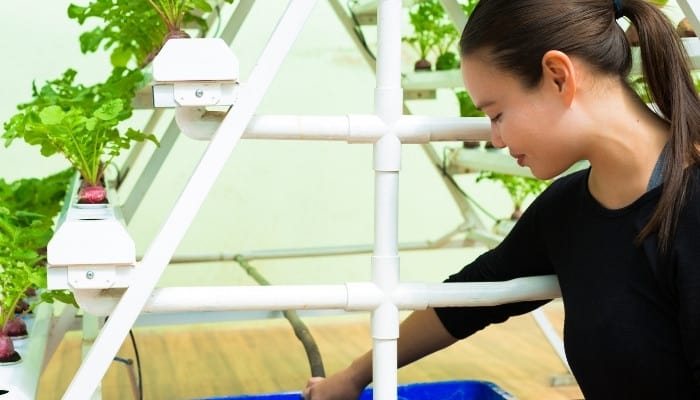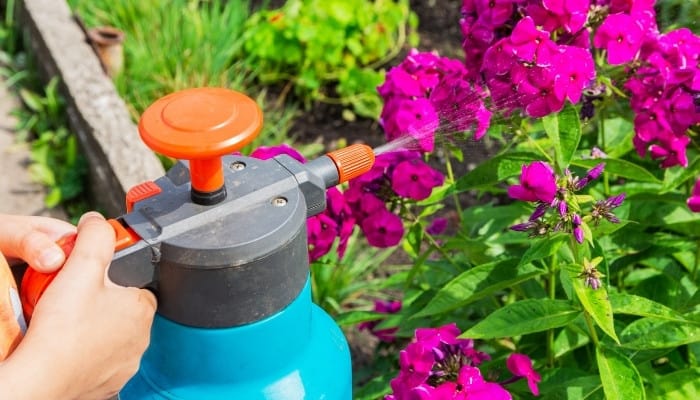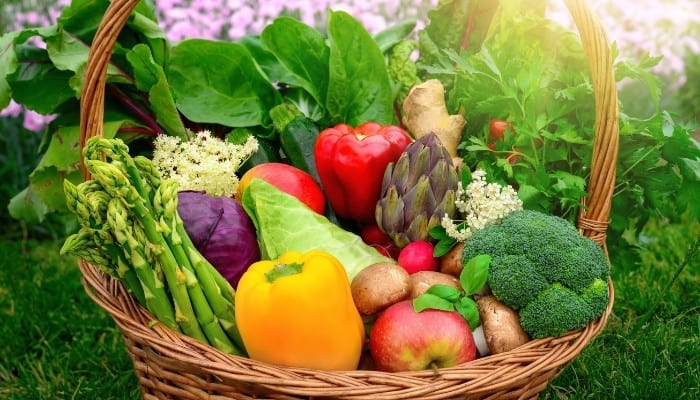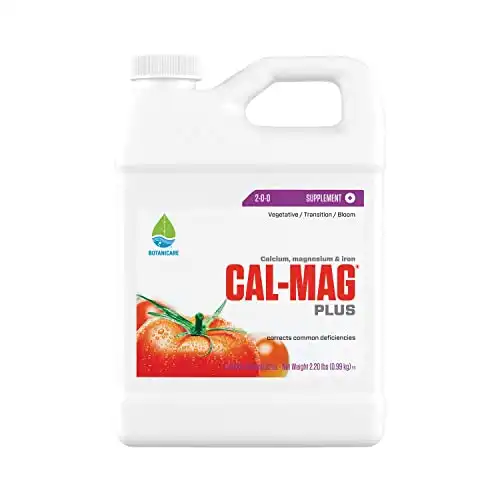Are you searching for the top supplement for your plants? Consider Cal Mag, a highly effective choice. Not only does it provide nourishment for plants, but it also plays a crucial role in the growth and production of flowers and fruits. Unlike typical fertilizers, Cal-Mag guarantees that your plants receive all the necessary nutrients for strong development and abundant yields.
Cal-Mag is a liquid supplement that provides calcium and magnesium for plants, along with iron. It’s particularly vital for hydroponic systems and soil-based plants, especially those in bloom or producing fruits and vegetables. This supplement delivers the micronutrients necessary for their growth.
In this article, discover how to spot and address Cal mag deficiency, a common issue manifesting as blossom end rot in plants. Learn about its effectiveness in various soil types, including clay soil and sandy soil, and how it enhances potting soil and raised beds. The guide also covers the importance of hydroponic nutrients in plant care maintaining healthy fruit plants, highlighting the significance of plant micronutrients.
Key Takeaways: Cal-Mag for Your Plant
- Symptoms of Calmag Deficiency: Plants deficient in calcium and magnesium exhibit yellowing of leaves, browning of leaf edges, curling leaves, stunted growth, and blossom end rot.
- Top Benefit of Cal-Mag: It enhances chlorophyll production, strengthens cell walls, boosts flower and fruit production, and improves nutrient uptake, effectively preventing common deficiencies.
- Cal-Mag Usage and Ratio: The typical recommendation for Cal-Mag usage is 1 teaspoon of powder or 5 milliliters of liquid per gallon of water, applicable for both hydroponics and soil gardening.
The Importance of Calcium and Magnesium for Plants
Calcium and magnesium are essential plant nutrients, critical for plants growing successfully. Calcium supports cell creation, affecting yields. Its lack slows growth and reduces fruits, vegetables, or blooms. Magnesium, central in chlorophyll, is crucial for energy conversion from sunlight. Magnesium deficiency leads to stunted growth.
Both elements raise growing medium pH, vital in water or soil. This is where cal mag for plants and cal-mag fertilizer play a role. Using Epsom salts, rich in magnesium sulfate, benefits potting media. For plant fertilizer, incorporating these elements is often essential. In most cases, plants only need a balanced nutrient solution. A fertilizer with cal mag for exceptional, ensuring robust growth and health.
How To Identify a Cal Mag Deficiency
The most obvious signs of a Cal-Mag deficiency are slow and stunted growth. Localized rot on buds, new leaves, fruits, and blooms are also a sure sign of a Cal-Mag deficiency.

Main symptoms of Cal-Mag deficiency in plants:
- Yellowing of leaves, especially between the veins.
- Browning of leaf edges and tips.
- Curling or cupping of leaves.
- Slowed growth and stunted development.
- Blossom end rot in fruiting plants.
- Weak stems and branches.
- Fruit and flower drop.
- Poor root growth.
Benefits of Cal Mag for Plants
| Benefit | Description |
|---|---|
| Enhances Chlorophyll Production | Magnesium in Cal-Mag is essential for chlorophyll production, aiding in photosynthesis. |
| Strengthens Cell Walls | Calcium strengthens plant cell walls, enhancing structural integrity and resistance to pests and diseases. |
| Boosts Flower and Fruit Production | Promotes better bloom formation and fruit set, leading to higher yields. |
| Improves Nutrient Uptake | Improves the efficiency of nutrient absorption from the soil or growth medium. |
| Prevents Common Deficiencies | Prevents symptoms of calcium and magnesium deficiencies such as blossom end rot, leaf yellowing, and curling. |
| Increases Plant Resilience | Helps plants better withstand stress from environmental factors, pests, and diseases. |
| Supports Overall Plant Growth | Both calcium and magnesium are vital for the healthy overall growth and development of plants. |
How Much Cal Mag Should I Use?
Using Cal-Mag is easy. Add a teaspoon of powder or 5 milliliters of liquid per gallon in hydroponics. For soil gardening, use the same amount per gallon in your watering can.
For example, for hydroponically grown tomatoes in a 20-gallon tank, how much Cal Mag should I use? You would need 100 milliliters for each water change. It’s good to add half to a full teaspoon per gallon when topping up the tank..
For a nutrient boost, add 10 to 15 milliliters per gallon. This dosage is ideal for both hydroponic systems and garden soil.
What Is the Best Cal-Mag Supplement for Plants?
Cal-Mag supplements are great for gardeners wanting to improve plant health and yield. The best overall Cal-Mag Supplement for plants is by far Cal-Mag Plus.
Let’s explore why Cal-Mag Plus is a favorite among gardeners worldwide.
Botanicare Cal-Mag Plus
Cal-Mag Plus is a specially formulated solution designed to fortify plants. It is used effectively for preventing deficiency commonly found in plants lacking micronutrients.
Cal-Mag Plus balances low calcium, magnesium, and iron in plants. It’s used for regular watering and as a micronutrient booster. Cal-Mag Plus is effective in various growing mediums and systems, including hydroponics, soil, LECA, coco coir, and more. It has an NPK of 2-0-0.
Pros:
- For use in water and/or spray.
- Provides calcium, magnesium, and iron.
- Works with most any plant types.
- For use in containers, soil, coco coir, and hydroponics.
Cons:
- Needs to be mixed with water before application.
Do You Need Cal-Mag in Hydroponics?
In hydroponics, while Cal-Mag isn’t essential, it’s highly beneficial for plant health. It provides key secondary nutrients that hydroponic plants might lack. Simply add Cal-Mag to the water reservoir during changes or top-offs, following product instructions. Adjusting pH levels post-application is important. For those using General Hydroponics systems, incorporating Cal-Mag is a good idea to promote healthy grow plants.

Here is how to Choose the Right Hydroponic Nutrients and Fertilizers
How to Use Cal-Mag in Hydroponics
Add Cal-Mag to the main reservoir of your hydroponic system when changing water or topping off levels. Follow the product’s instructions for mixing the right amount with water. Remember that adjusting pH levels before and/or after adding Cal-Mag is required to maintain optimal growing conditions. Cal-Mag is great for preventing calcium deficiency in hydroponic systems, alternatively beneficial compared to traditional methods used for acidic soil.
Effectiveness of Cal-Mag in Different Soil Types
Cal-Mag works well in different soils, like clay and sandy soil. It enhances potting soil and is advantageous for plants in raised beds. Cal-Mag helps with calcium deficiency, common in soils with fewer nutrients.
| Soil Type | Recommendations |
|---|---|
| Clay Soil | Apply sparingly, as clay retains nutrients. Ideal for calcium deficiency. |
| Sandy Soil | Use regularly, as sandy soil drains quickly and may lack nutrients. |
| Potting Soil | Mix it into your regular watering for potting soil lacking nutrients. |
| Raised Beds | Add it to raised beds now and then, mainly if the soil is low in calcium and magnesium. |
Should I Use Cal-Mag With Water?
You don’t need to use Cal-Mag every time you water, only if your plants lack nutrients. After an initial treatment, regular application in every watering isn’t required. If watering occurs more than once a week, limit Cal-Mag use to just one of those sessions.
Frequently Asked Questions (FAQ):
Do I Need to Mix Cal-Mag With Nutrients?
Cal-Mag can be used in tandem with nutrients. It can also be added before or after feeding your plants with nutrients. Cal-Mag boosts how well plants take in nutrients when combined with them.
Should I Use Cal-Mag During Flowering?
Using Cal-Mag during flowering depends on your choice and judgment. It’s not always needed for plant health but can be used for better blooms or fruit.
If you notice Cal-Mag deficiency during flowering, here is how to fix it!
Can Cal-Mag Be Used for a Foliar Spray?

Cal-Mag, especially Cal-Mag Plus, works great as a foliar spray. Simply mix it with water and use it to spray as you typically would. But, don’t use other products with Cal-Mag as a spray, it could cause issues like mold.
Should You Use Cal-Mag as Fertilizer for Tomatoes?
Calcium and magnesium are a couple of the most crucial nutrients for growing amazing tomatoes. Many gardeners use these nutrients, often adding things like eggshells to the soil.
Forget about grinding messy eggshells and constantly scooping them out around your tomato plants. Instead, add a teaspoon of Cal-Mag to your water. That way, you take the guesswork out of whether or not your tomatoes will be fat and juicy.
Is Cal-Mag Good for All Plants in Your Garden?
Cal-Mag may not be necessary for plants that are super healthy and growing in an amazingly well-cared-for environment, but for just about all other plants, it is definitely helpful.
One of the best parts about feeding plants with Cal-Mag is that it works well for nearly any species you can think of and it’s hard to overdo it.
Will Cal-Mag Raise pH?
Depending on the version of Cal-Mag you’re using, it may slightly affect pH levels one way or the other. Make sure to read the label of your Cal-Mag product regarding its effect on pH levels.
When using Cal-Mag in hydroponic systems, it’s highly recommended to adjust pH levels accordingly before use with Cal-Mag (anticipating its regular effect on the pH of your system) as well as testing and adjusting properly afterward.
Having an accurate pH monitor, like this American-made pH tester, on hand will eliminate any guesswork and ensure you’re maintaining proper levels for your plants.
Does Cal-Mag Raise EC?
Cal-Mag products may raise EC levels by as much as 0.5, which is quite a jump. Most hydroponic systems shoot for an EC of around 1.0.
Using Cal-Mag without testing EC levels with an accurate tester like this, could be damaging to your plants, as an improper EC level makes it hard for plants to absorb water, nutrients, and oxygen.
Is Cal-Mag Organic?
Not all Cal-Mag is completely organic. FoxFarm Bush Doctor, TPS Cal-Mag OAC, and Roots Organics Cal-Mag are, however, completely organic sources of calcium and magnesium.
Natural Cal-Mag products don’t include nitrogen, phosphate, or potassium.
Does Cal-Mag Have Nitrogen in It?
The older versions of Cal-Mag products were mainly made with nitrogen, and some of the products do still have nitrogen in them.
That said, there are numerous organic Cal-Mag products that have zero nitrogen in them.
What Is Cal-Mag Made Of?
The recipe for Cal-Mag is simple yet potent: calcium nitrate and magnesium nitrate, though many contain iron as well.
Some products may contain additional micronutrients, such as zinc, copper, boron, manganese, sulfur, and fulvic acid.
Does Cal-Mag Kill Microbes?
Cal-Mag doesn’t kill microbes. That said, it is theoretically possible that if used in copious amounts, the iron EDTA levels could affect microbes.
The issue with this idea is that the iron EDTA levels would kill the plants long before they affected present microbes.
Can You Use Cal-Mag in Soil?

Cal-Mag can absolutely and should be used in soil. That’s because it doesn’t affect the main level of macronutrients (or NPK) of plants but greatly aids the micronutrients present in the soil for plants to feed on.
Calcium and magnesium are the main two supplements plants need to grow and remain healthy, besides the main nutrients nitrogen, phosphorus, and potassium. Cal-Mag is the only source of these micronutrients that your plants will need.
How To Use Cal-Mag With Soil-Based Plants
Cal-Mag is very easy to use with soil-based plants. Just mix in one teaspoon of Cal-Mag to every gallon of water. Apply the solution to your garden just as you would normally water it.
To use Cal-Mag as a booster, accelerate your plant life by adding an extra teaspoon to each gallon of water (two teaspoons total) before feeding your plants.
How Much Is a Bottle of Cal-Mag?
Depending on the size of the Cal-Mag product and the retailer you shop with, Cal-Mag costs around $18 to $20 for one quart and between $35 and $40 for one gallon.
That said, there is a range of Cal-Mag products from which to choose, and prices may vary.
How Do You Make Homemade Cal-Mag?
Cal-Mag can be made at home, but there is no guaranteeing how successful it will be in comparison to actual Cal-Mag products. To make a homemade Cal-Mag solution, mix roughly two parts calcium to one part magnesium.
A general rule of thumb for measuring homemade Cal-Mag is a single tablespoon of calcium phosphate mixed with a single tablespoon of Epsom salt into a single gallon of water.
Pro Tip: A single tablespoon of molasses may be used in the absence of Epsom salt.
Does Cal-Mag Go Bad?
It is unclear exactly how long Cal-Mag lasts, but the general opinion is that it takes a very long time for the product to go bad. Many gardeners claim Cal-Mag works even after it is several years old.
At any rate, if you use it within the first few years after purchasing it, you’ll not have to worry about it going bad.
When Should I Stop Using Cal-Mag?
You should stop using Cal-Mag on your plants as soon as they visibly seem to have recovered from the nutrient deficiency.
If your plants seem happy and healthy, there is no need to continue adding Cal-Mag with every watering.


